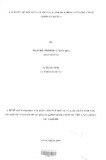| dc.description.abstract | Financing decisions is an important managerial task. Business managers must consider
sources of financing available and their relative costs as well the financial risk. Tangible
assets, such as fixed assets can support a higher debt level as compared to intangible assets,
such as growth opportunities. The tax trade-off models predict that profitable companies will
employ more debt since they are more likely to have a higher tax burden and low bankruptcy
risk. This study therefore sought to find out the sources of finance for building construction
firms in Kenya.
The objective of the study was to establish the various ways in which building construction
firms finance their operations. The study used both quantitative and qualitative analysis for its
research methodology. The total population of interest comprised of 1799 firms according to
the Ministry of Roads and Public Works, 2006. A sample size of 34 firms was included in the
study. Primary data was collected by questionnaire method.
The result of the study showed that that for the construction firms involved in the survey,
most of them reported that they faced hurdles in raising finance and these hurdles emanated
from the high interest and the smallness in size of the firm. This is the reason why most of
them did not have adequate equipment. The firms therefore did have intention of increasing
their capital and this was mainly through bank loans. The firms involved in the study
published their accounts annually while a few did not publish their accounts at all. Fewer still
engaged external auditors to verify their books of accounts.
Earnings were considered a great risk while funding was ranked a moderate risk by most of
the participants in the survey. For most firms involved in the study they considered equity to
be least expensive and bank loans as being the most expensive. The companies involved in
the survey also listed the main challenges they faced including competition and funding. | en |

